Galápagos Islands
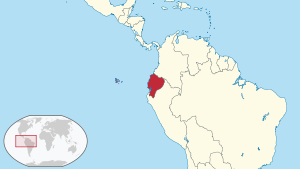
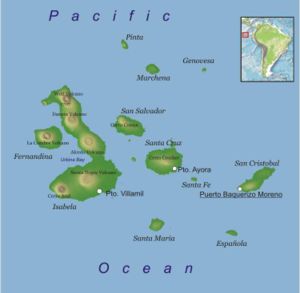


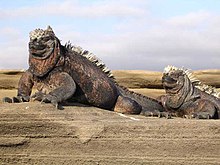



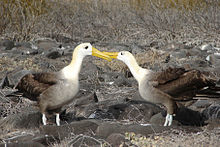


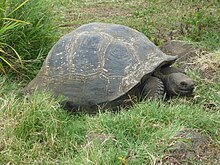
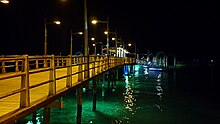
The Galápagos Islands (Archipiélago de Colón in Spanish) are a group of islands in the Pacific Ocean which now belongs to Ecuador. The islands are famous for having many native animals, including giant tortoises, that are found nowhere else on Earth. These animals helped Charles Darwin towards his theory of evolution by natural selection after he visited the islands in 1835.
97% of the islands are a national park, all except the inhabited parts. The Galápagos National Park is a UNESCO World Heritage Site (1978),[1] a marine reserve (1980), and a biosphere reserve (1986).[2]
Place[change | change source]
The Galápagos Islands are on the equator, 973 km (604 miles) west of Ecuador in South America. There are 19 islands with a total of 8,010 square km (3,093 sq. miles) of land.[3] The islands were made from volcanoes, and volcanoes are still making the islands of Isabela and Fernandina today. The most recent volcanic eruption was the Wolf Volcano in early January 2022 on Isabela Island.
People[change | change source]
2001, about 18,000 people lived in the Galápagos Islands.[3] Most people have come from mainland Ecuador to live in the islands within recent years (about 3500 people lived on the islands in 1972). Most people are from the Mestizo ethnic group, which are the descendants of Spanish and Native American peoples.
People live on only 5 of the 19 islands of the Galápagos: Baltra, Floreana, Isabela, San Cristobal and Santa Cruz. Puerto Ayora is the biggest town, where about 10,000 people live. Puerto Ayora is on Santa Cruz Island. The second biggest town is Puerto Baquerizo Moreno on San Cristobal with about 5,600 people. Puerto Villamil is the town of Isabela Island, where about 2,000 people live. There are approximately 30,000 people living in the Galapagos as of 2012.
Tourism has steadily grown over the last two decades; in 2012 it is estimated that 200,000 tourists will visit the Galápagos Islands.[4]
Galápagos Province[change | change source]
The islands are one of the 24 provinces of Ecuador. The capital of the province is Puerto Baquerizo Moreno, a town with 5,600 people.
There are three cantons in the province. Each canton has a seat, which is a town like a capital. All of the islands of the province are in one of the three cantons.
| Canton | Canton seat | Main islands |
|---|---|---|
| Isabela canton | Puerto Villamil | Darwin, Fernandina, Isabela, Wolf |
| San Cristóbal canton | Puerto Baquerizo Moreno | Española, Floreana, Genovesa, San Cristóbal, Santa Fe |
| Santa Cruz canton | Puerto Ayora | Baltra, Bartolomé, Marchena, North Seymour, Pinta, Pinzón, Rábida, Santa Cruz, Santiago |
Related pages[change | change source]
Noteworthy species[change | change source]
Noteworthy species include:
- Iguanas
- Galápagos land iguanas, Conolophus spp.
- Marine iguana, Amblyrhynchus cristatus, the only iguana that feeds in the sea
- Chelonia
- Galápagos tortoise (Galápagos giant tortoise), Geochelone elephantopus, known as galápago in Spanish, it gave the name to the islands
- Galápagos green turtle, Chelonia mydas agassisi, a subspecies of the green turtle
- Birds
- Flightless cormorant, Phalacrocorax harrisi
- Great frigatebird and magnificent frigatebird
- Blue-footed booby, Sula nebouxii, popular among visitors for their large blue feet which they show off in courtship
- Galápagos penguin, Spheniscus mendiculus, the only living tropical penguin
- Waved albatross, Phoebastria irrorata, the only living tropical albatross
- Galápagos hawk, Buteo galapagoensis, the islands' main scavenger and "environmental police"
- Four endemic species of Galápagos mockingbirds, Nesomimus, the first species Darwin noticed to vary from island to island
- Thirteen endemic species of tanagers, popularly called Darwin's finches. Among them is the Sharp-beaked ground finch Geospiza difficilis septentrionalis which is sometimes called the "vampire finch" for its blood-sucking habits, and the tool-using woodpecker finch, Camarhynchus pallidus
- Mammals
- Galápagos sea lions, Zalophus wollebaeki, closely related to the California sea lion, but smaller
- Echinoderms
- Sea cucumbers, the cause of environmental battles with fishermen over quotas of this expensive Asian delicacy
References[change | change source]
- ↑ UNESCO, "Galápagos Islands"; retrieved 2012-4-21.
- ↑ World Network of Biosphere Reserves (WNBR), "Archipielágo de Colon (Galápagos)"; retrieved 2012-7-18.
- ↑ 3.0 3.1 "Galapagos Islands". Encyclopaedia Britannica Online. Retrieved April 22, 2009.
- ↑ "The Galapagos Islands Fact Sheet". Galapagos Conservation Trust. Archived from the original on March 7, 2009. Retrieved April 22, 2009.
Other websites[change | change source]
